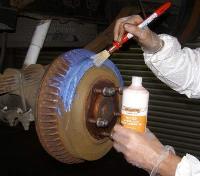 Add My Company
Add My Company
Sign In

Rustbuster Fe-123 coated over bright clean metal.
Rustbuster has over the years had a number of enquiries asking, ‘why has my converter not changed colour’ or more painfully when EM121 Epoxy Mastic and topcoat has been applied ‘Why do I have rust spots coming through’.
We lets break this into two clear questions,
Why has my converter not changed colour?
• There was no rust to convert. Remember that Fe-123 can only work where there is rust to convert. When applied to non-corroded metal, no reaction can take place.
• Conditions were too cold. As mentioned above, cold conditions can affect performance. As a guide, 20c is an optimum temperature, with 10c the minimum. If working in a cold workshop, we suggest heating the ambient temperature around the area you are working on prior to and after application.
• Two coats were applied. Two coats is not a good idea unless it's obvious that you have missed a section. A second coat applied over a reacted coat will just turn a sort of toffee colour where the resin dries with nothing to react to.
• The converter was applied to a painted surface. Fe-123 is also likely to turn a toffee colour when applied over paint. There is no need to apply converter to a painted surface. If there are small rust spots on the surface of the paint, carefully apply Fe-123 only to those areas (‘spot priming’).
• Too much converter was used. Use only enough Fe-123 as required to react with the surface of the steel. The Fe-123 is to be used as a surface treatment, not a thick coating.
Fe-123 is a Tannic Acid based rust converter and is designed to convert surfaces iron oxides into the stable iron tannate. Once converted the surface is left bound in latex containing zinc phosphate.
Fe-123 envelopes rust at a molecular level, developing into a neutral layer which exists between the steel's surface and the atmosphere. This neutral layer prevents the migration of ions so that no chemical reaction can occur at the metal's surface.
Why do I have rust spots coming through?
This question has been raised when a customer had applied 2 coats of Em121 Epoxy Mastic and a topcoat, after a period of time they notice small orange spots bleeding through the coatings and assumed this was rust. After testing flake samples sent, we found out that the samples contained un-converted Rustbuster Fe-123. The tannic acid used in the converter was bleeding through.
Acid is a known corrosion rate accelerator and will try it’s hardest to pull moisture to it, in this case the moisture can’t get through the Em121, so it pulls the tannic acid to the surface staining the coating on its way through. This orange staining can be mistaken for rust. This was more evident in this case as the Em121 used was Buff an off-white colour with a light cream topcoat, if this was Black it’s highly likely the aesthetic would not have been seen. Below you'll see an image sent in by a customer you'll the the tannic spots staining the light grey but not the black.
This staining process can also be often seen in tannin rich timbers such as redwood, cedar, and mahogany, without the correct primer painting this resinous wood can be problematic. Have you ever simply painted over a timber knot, and it’s stained through the coating? This is the tannin bleeding through the coating much like un-converted tannic acid.
For more information on Experiencing issues with Fe-123 rust converter? talk to Rustbuster Ltd
Enquire Now
List your company on FindTheNeedle.

